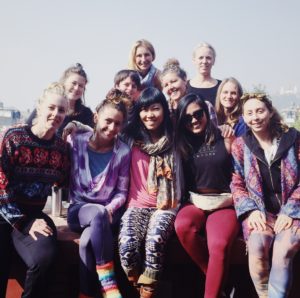Trauma-Informed Yoga Alliance Teacher Training
15th – 25th April 2022
Online Virtual Training
Are you ready to up-skill your yoga qualifications to learn how to respond to trauma in your students more effectively?
Or perhaps you are looking to understand your own experience of trauma, and to heal yourself with yoga?
In this specialized online 100 Hr Trauma-Informed Yoga Teacher Training, you will be inspired and empowered to take yoga out from the “asana” into a deeper dimension of healing and transformation for the world.
Join our community of trauma-informed yoga teachers, who are committed to their own personal healing, and seek to take yoga out into marginalized populations all over the world, to create a deeper contribution to the world!
Are you ready to expand your impact in the world through yoga and an embodied understanding of trauma in the Body, Mind and Spirit?
This Yoga Alliance YACEP certified online yoga training is designed for you to learn, not just through theoretical knowledge, but through somatic and embodied practices, group discussion, video lectures and yoga workshops, and valuable placement and supervision so that you can be immersed in this content holistically. There is also a strong focus on social activism and innovation in this training which is unique and powerful for teachers wanting to make a sustainable change in the world on a heart-centered and practical level.
This unique program is led by Somatic Experiencing™ Therapist, yoga teacher, TED speaker, #1 bestselling author, and social activist Atira Tan, (PhD. Candidate, MA Art Therapy, SEP, 500 E-RYT) founder of both Art to Healing, an Australian charity which supports the psychological recovery of sex-trafficked survivors, and Yoga for Freedom, which has raised over $65,000 for the fight against child sex slavery. Atira is a wealth of knowledge and wisdom, distilled from her 17 years of experience working with marginalized populations and communities around the world.



This training provides life-long tools for you as a yoga teacher to create safer spaces in your classes and amplify your therapeutic presence, as well as the foundation of understanding of the impact of trauma on the body, mind, and emotions.
You will also learn how to respond with empathy, compassionate presence, and attunement with your students, in turn, creating a more wholehearted, healing presence in the world.

“What a life-changing experience. This training is a true treasure of knowledge and wisdom and shared with a caring and loving presence. The depth of insights into a variety of tools to create safer spaces is the most I have ever experienced in any training. But besides the theoretical teachings, what touched me the most was how space was held and naturally became the soil for our personal softening into the journey. And with that, we were able to truly experience the effect of a teacher who fully embodies what she teaches. And that is a priceless gift I will benefit from for the rest of my life.”
Join Us To:
* Improve your ability to create safer spaces
* Identify patterns of trauma in your students
* Learn which yoga asanas heal, and which can harm
* Trauma-Informed language and cueing which create safety
* Learn the Art of Therapeutic Presence
* Understand the foundations of trauma and how it impacts the nervous system.



This training is perfect for you if you’re looking to:
“Both Gemini and Atira are not only GREAT yoga teachers, they know everything there is to know about trauma and how to teach yoga accordingly. Not only are they great teachers; both of them also have amazing personalities and loveliest laughter and humor. Their standards are really high, so are their ethics.
I have learned SO much more than I could have ever expected. I highly recommend this teacher training to anyone interested in healing traumas of their own or/and others.”

Our Curriculum
Our curriculum covers a comprehensive dive into the deeper dimensions of trauma, facilitation and healing which will prepare you to teach in this new approach with confidence and awareness.
Many past students are now teaching trauma-informed yoga to marginalised populations such as refugees, asylum seekers, sex trafficked girls and women, and women shelters around the world. We continue to mentor and supervise our students so that you can receive the proper support to take yoga off the mat, and into the world to create more therapeutic and empathic spaces for healing and recovery.
Learn how to work with groups, privates or in community settings with populations such as people suffering from PTSD, violence, war, sexual abuse, anxiety and depression, refugees and asylum seekers and more. In this training, you will also learn how to tailor your studio classes to those who may be unaware of how unresolved trauma may be impacting their bodies, emotions and lives.
What you will receive:
| 16 hrs |
Yoga class videos (to start our training days, done in the comfort of your own home)
|
| 16 hrs |
Video lectures (for you to watch beforehand and to keep)
|
| 46 hrs |
Zoom conferencing in-person virtual workshops & classes
|
| 2 x |
Individual supervision sessions with Atira.
|
| Ongoing |
Email and WhatsApp contact throughout the course.
|
| Ongoing | Private FB group where you can ask questions. |
OUR SUBJECTS
MODULE 1: THE FOUNDATIONS OF TRAUMA
MODULE 2: ESSENTIAL ELEMENTS OF TRAUMA-INFORMED YOGA
MODULE 3: TAKING IT INTO THE WORLD
Module 1: The Foundations of Trauma
Subjects: |
Key Objectives: |
|---|---|
|
1. Foundations of Trauma-Informed Yoga: The Importance of TIY Principles |
|
|
2. Overview of Trauma & the Nervous System: The Psycho-physiology of Yoga & Trauma. |
|
|
3. Different Categories of Trauma: The Signs and Symptoms in the Body. |
|
| Subjects: | Key Objectives: |
|---|---|
| 1. Foundations of Trauma-Informed Yoga: The Importance of TIY Principles |
|
| 2. Overview of Trauma & the Nervous System: The Psycho-physiology of Yoga & Trauma. |
|
| 3. Different Categories of Trauma: The Signs and Symptoms in the Body. |
|
Module 2: Essential Elements of Trauma-Informed Yoga
Subjects: |
Key Objectives: |
|---|---|
|
4. The Art of Therapeutic Presence: How Regulation and Resourcing is Vital |
|
|
5. Essential elements of Trauma-Informed Yoga Part 1: Asana, Meditation, Philosophy & Pranayama |
|
|
6. Essential elements of Trauma-Informed Yoga Part 2: Trauma-Informed Cueing, Adjustments, Consent, Boundaries, and Language |
|
| Subjects: | Key Objectives: |
|---|---|
| 4. The Art of Therapeutic Presence: How Regulation and Resourcing is Vital |
|
| 5. Essential elements of Trauma-Informed Yoga Part 1: Asana, Meditation, Philosophy & Pranayama |
|
| 6. Essential elements of Trauma-Informed Yoga Part 2: Trauma-Informed Cueing, Adjustments, Consent, Boundaries, and Language |
|
Module 3: Taking Trauma-Informed Yoga Into The World
Subjects: |
Key Objectives: |
|---|---|
|
7. Cross-Cultural Sensitivity: Taking Trauma-informed Yoga to the World |
|
|
8. Teaching & Integration: Practicing and Creating TIY Programs & Classes In The World |
|
| Subjects: | Key Objectives: |
|---|---|
| 7. Cross-Cultural Sensitivity: Taking Trauma-informed Yoga to the World |
|
| 8. Teaching & Integration: Practicing and Creating TIY Programs & Classes In The World |
|
This YTT comprises of 80 hours of contact hours, and 20 hours of non-contact hours. Please note that there will be additional reading and homework assignments to integrate your learning will be required.


“Since the training, it’s been really exciting. I‘ve been teaching a trauma-informed yoga class at a private counselling centre for rape survivors, and I just got hired to teach at an outpatient treatment facility. I’ve also partnered with a local counsellor and we’re offering CEU classes for mental health professionals to learn how they can incorporate trauma-informed yoga techniques into their sessions.”
– Lisa Orozco, Equine Therapist & Yoga Teacher, USA
What our Students Say…
Our Social Change Model
“Paying It Forward”
We believe that every girl and woman deserves to determine her future.
As part of our feminine social change model, this teacher training “pays it forward” to assist women and girls from Nepal who has experienced sex slavery and exploitation to also receive valuable therapeutic support and education.
$50 from your fee in this teacher training will sponsor ONE woman in Asia to receive therapeutic support and mental health care in shelter programs, providing the chance for these girls to live a life free from slavery with our charity partner Art to Healing.
Investment
Full Price: €1379
Early Bird before 30th Jan 2022: €1179
Registration Deposit: €300 (non-refundable)
This includes all tuition fees, your PDF trauma-informed manual, your yoga alliance certified certificate, and a contribution to our “Pay it Forward” social change initiative of supporting 1 woman who has experienced sex slavery in Asia to also receive valuable trauma-informed yoga & therapeutic support too.
Schedule
DAY 1 – 11:
1st Virtual Live Workshop: 9 – 11.30 am (CEST)
2nd Virtual Live Workshop: 12.30 – 3 pm (CEST)
Each day, you’ll receive 1 x 2 hour yoga video for your morning practice, or you can do this in your own time. The yoga videos are for your keeping and are available to watch and download.
You’ll also get 2 x 1 hr video lectures to watch before our Live Virtual Workshops. These video lectures are also for your keeping, and available for downloads.
In addition, our Virtual Workshops will be recorded, and for your keeping and available to download.
You will also receive a 120 page TIY PDF Manual after the training is over.
Online Virtual Yoga Teacher Training
NORMAL PRICE: €1379
NOW: Only €1179 (Early Bird Offer ends 30th Jan 2022)
*Pay your €300 deposit to reserve your space. Remainder due 1st Mar 2022.
Promo Code: YOGAHEALS22
You’ll receive:
- 16-hour yoga class videos (to start our training days, done in the comfort of your own home)
- 16 hours of video lectures (for you to watch beforehand and to keep)
- 42 hours of zoom conferencing in-person classes
- 2 x individual supervision 1 hr sessions with Atira Tan
- Email and Wassapp contact throughout the course
- Private FB group where you can ask questions.
In addition, you’ll be required to do:
- 4 hours of additional homework, required reading and journaling.
- 20 non-contact hours of observational notes, practice teaching and assignments due on the 31st July.
As part of our training, you will be required to partake of required reading, homework assignments, observational classes, practice teaching classes and reflection essays.
The dateline for the teacher training assignments, homework and essays are due on the 31st of July 2022.
WE ARE A YOGA ALLIANCE TRAINING AND REGISTERED WITH YACEP.

I’ve been teaching yoga for 5 years and would have loved this information in every yoga training I’ve done. This content is so profound and important. It changes your perspective on what trauma is, and how to respond. For me, it was like a window which opened. It has changed my teaching, as well as my life off the mat. I am now teaching with Art to Healing as a Trauma-Informed Yoga Teacher with girls who have experienced child sex slavery.”
– Lisa Mosvich, Yoga Teacher, Germany.

YOUR TEACHERS
And we are super passionate about making a difference in the world through yoga!
Art to Healing:
Trauma-Informed Yoga in Women Shelters
Atira Tan’s TED X Talk:
Inspired Action from the Heart

“This 100-hr Trauma-Informed Yoga Teacher Training with Atira was beautifully organized and layered. Both on a personal and professional level, this training brought new insight, awareness, and growth in understanding the world of yoga teaching, and in navigating life with greater confidence and ease. It is an absolutely invaluable experience, and one that I wish every single yoga teacher out in the world has the opportunity to participate in one day.”
– Stephanie Maren, Mother & Yoga Teacher, USA




